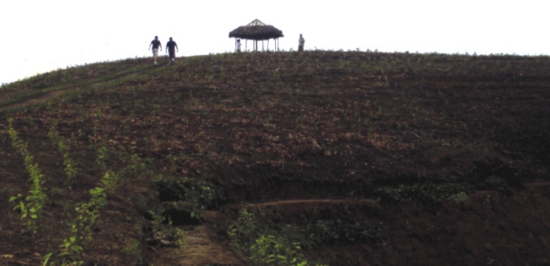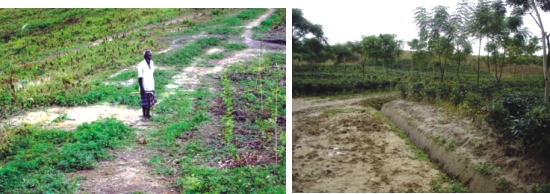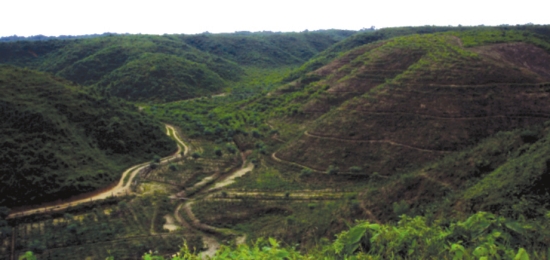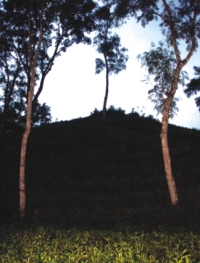|
Travel
Tea Time in Sylhet
Shara Azad

The guard's hut atop one of many hills
School's out for the summer, and parents are fleeing Dhaka left and right in pursuit of a vacation to occupy the kids. They needn't look far, however, as Bangladesh is chockfull of exciting getaways, though it sometimes may seem to the contrary. For example, just 250 kilometers north of Dhaka (only a four hour drive!) is Sylhet, which has scenic views that are sure to enchant any child or city-dweller.
I was recently fortunate enough to have been invited to spend the weekend at a family friend's tea estate, Ootterbhag, in Sylhet. The drive there was long, especially because of the traffic congestion in leaving Dhaka and a bumpy portion at the beginning of the mostly smooth National Highway Two (the Dhaka-Sylhet highway), but eventually we made it after careening around several cattle and CNGs on the road and a pit stop at the retro roadside Hotel Ujan Vati for refreshment.
In approaching the tea estate, I also passed through the main city portion of Sylhet, which is very much like Dhaka, but with a few notable differences. The foremost distinction about Sylhet as a city is that between the typical cement buildings there is the occasional house randomly made out of marble or wood with a slanted roof. This is because most Bangladeshis living abroad are Sylheti, so they occasionally maintain the western influence in architecture when returning to Bangladesh or they regularly send such materials and ideas back home. In fact, the Sylheti economy primarily runs on the money sent by expatriates, something completely unique to that particular district of Bangladesh.
 |
| A tea-garden labour ready for work |
Rows and rows of tea plants |
After I passed the city, I essentially entered Tealand. For kilometres and kilometres, all I could see were dense shrubs, literally packed onto numerous, rolling hills. As the road wove its way through the miniature mountains, a travelling companion of mine, Wahidul Siddiqui, noted that it felt “a bit like a Formula One race track,” possibly because of the serpentine nature of the road. And truly, while it was tricky to navigate the way through the hills, the surrounding view of the thousands of tea plants was so beautiful and different from the smog and bustle of Dhaka that it was worth it.
Eventually, I reached my destination, a family friend's bungalow situated atop a grassy knoll that overlooked the tea gardens below. Unfortunately though, Sylhet is notorious for its rain, and on that first day it had rained so much that we were unable to explore the gardens. I did have the opportunity to meet several of the tea labourers who worked at the estate, however, and noticed that their situation, while better than that of the many living impoverished in Bangladesh, was reminiscent of the British imperial era, when Bangalis worked for their British masters, focusing solely on their work. On the other hand, the tea estate workers seemed very gentle and trustworthy, which gave us visitors a calming sense of safety, an idiosyncrasy as we were literally in the jungle.

The Ootterbhag tea estate
On the second day, the sun was shining, and so everyone staying in the bungalow headed out to explore the tea gardens. It was a fairly tough hike, as tea grows best on hillsides where they can get the sun and shade they need, yet we all managed to trek up one of the highest peaks, overlooking the estate. What a spectacular view it was! Driving through the gardens had been lovely, but seeing the entire estate, with its red soil contrasting lush green hills in every possible direction, from above against the horizon was absolutely breathtaking. Even though I have travelled a fair bit, I must say that I have never seen anything so naturally beautiful in the world.

Dusk at Ootterbhag |
On the way back to the bungalow, I learned a bit about the tea itself. Apparently, tea plants are very demanding. In addition to good amounts of sun and shade, they need a great deal of rain, making Sylhet the perfect place for the plants to flourish. Furthermore, tea plants grow to become thickly-leaved shrubs, but the best tea comes from the little leaf sprouts, which are in that stage of life for a limited amount of time, so the leaves must be picked at a precise moment. However, once a tea plant begins to grow, which one can predict with a tea indicator, a wild plant that pops up in the soil most fertile for tea, they are very easy to maintain since Mother Nature does most of the work.
I had never really thought about where my morning cup of “rong chaa” comes from, but I was honestly fascinated by the tea making process and the flora and fauna I saw during my trip. What's more is that my young cousins, who accompanied me, enjoyed their time in the great outdoors and began to develop an affinity for the aforementioned amber ambrosia. Therefore, I think a trip to Sylhet's tea gardens is definitely worthwhile for any family because apart from the wonderful experience, you will surely come back with several bags of delicious tea.
.Copyright
(R) thedailystar.net 2008 |
|
